Lithops Seeds Mix (Living Stones)
Lithops Seeds Mix (Living Stones)
"What are they"? Commonly known as "Living Stones" they seem capable of fooling humans as well as animals.

Delivery
All orders shipped with UPS Express.
Always free shipping for orders over US $250.
All orders are shipped with a UPS tracking number.
Returns
Items returned within 14 days of their original shipment date in same as new condition will be eligible for a full refund or store credit.
Refunds will be charged back to the original form of payment used for purchase.
Customer is responsible for shipping charges when making returns and shipping/handling fees of original purchase is non-refundable.
All sale items are final purchases.
Help
Give us a shout if you have any other questions and/or concerns.
Email: contact@domain.com
Phone: +1 (23) 456 789
Availability: In stock
SKU
Lithops
Lithops are plants. This may seem a rather obvious statement but the most often asked question when people first encounter these little wonders of nature is "What are they"? Commonly known as "Living Stones" they seem capable of fooling humans as well as animals. They belong to the plant family Mesembryanthemaceae (Aizoaceae). The word "lithos" is Greek means "stone". Lithops originate from South Africa and Namibia where they have become highly adapted to conditions of extreme heat and drought. About 200 varieties and cultivars are presently known. Lithops make an ideal plant for the collector. They are one of the most popular of all the succulents. Their small size and slow compact growth, means that an impressive collection can be grown in a relatively small area. They make ideal houseplants. Lithops can under ideal conditions live for about 50 years in cultivation.
The fascination and interest provided by Lithops comes from the considerable variation in the patterns and colours of the plant bodies. Some varieties can exhibit considerable variance within themselves, so along with hybrids that are often available the amount of different plants for the collector is almost limitless. Their shape, size and color causes them to resemble small stones in their natural surroundings. The plants blend in among the stones as a means of protection. Grazing animals which would otherwise eat them during periods of drought to obtain moisture usually overlook them.
To minimise any evapouration the leaves have become so truncated that they have lost the appearance of a normal leaf and have become rounded like a pebble. There is no stem as such, but rather the taproot joins abruptly at the base of the leaves. The leaves are thick to store enough water for the plants to survive for months without rain. They have patterned and coloured top surfaces similar to those of stones in the surrounding area .The flattened top part of the leaf (apice) is window-like. This window performs a very important function, allowing light to enter the plant body where the sun's rays activate cells which assist with the photosynthesis process. Another interesting phenomena is during extreme droughts, Lithops plants can pull themselves into the soil to such an extent that they actually become semi-subterranean. In this way they are not exposed to the harsh outside elements that could dry them out even further.
When the plant starts to flower, the bud emerges through a groove in the middle of the fissure. The fissure is the spilt between the two leaves. Flowers are solitary and are borne on a short stem. The majority of Lithops produce their flowers during autumn and early winter. They are daisy-like and yellow or white depending on variety. They first open during the afternoons of sunnier days. The flowering of the plants is related to the amount of light they receive during the spring and summer months. Lithops usually must be three to five years old before they begin flowering .The flowers of many of the Lithops species have a spicy-sweet scent.
Hardiness zones 10-11, (1øC/35øF, 4øC/40øF). Lithops should not be exposed to temperature lower than 40øF (5øC). Lithops should be left totally dry throughout winter and early spring. During this period the plant will generate a new body. The new body will consume the moisture and nutrients of the previous body as it completes its growth. This process should be visible by early spring. Throughout the winter and spring keep the plants cool but avoid freezing.
Watering can commence once the remains of the old plant body are shrivelled and drying. The remains of the old bodies and any flower stems can be carefully removed when they have become thoroughly dry. This can be any time during May to July depending on variety. When watering soak the compost fully. The soil should be allowed to dry out between waterings. In late spring or early summer, the plants will begin to go dormant. In habitat, it is necessary for their survival to rest during the long period of intense heat and little or no rainfall, using what water they have stored previously to last the summer. In the fall, usually in August or September, the plants will begin growing. Nearly all problems occur as a result of overwatering and poor ventilation.
They need a good amount of direct sunlight when grown as houseplants. Usually a southern window is the best location, unless it exposes the plants to full sunlight most of the day, which should be prevented. The soil mix should be a type that drains quickly. Pots that are about 3 - 5 inches deep are recommended to allow the roots adequate room to grow.
Any general purpose compost with some added grit to help drainage is suitable or any of the propriety cactus composts is ideal. An occasional feed as for houseplants is permissable but don't over do it, Lithops require little in the way of nutrients.
| Common name | Living Stones |
|---|---|
| Species | Lithops ssp. |
| Germination | The most effective manner to sow seed is to use a well-drained substrate. It is not necessary to cover the seed with anything. Just keep the substrate moist to stop germinating seedlings from drying out. Whilst the seed is germinating, use a very fine mister when watering. The seeds germinate relatively quickly. In just under a year they are ready for transplanting. |
| Price View | Price Range |

